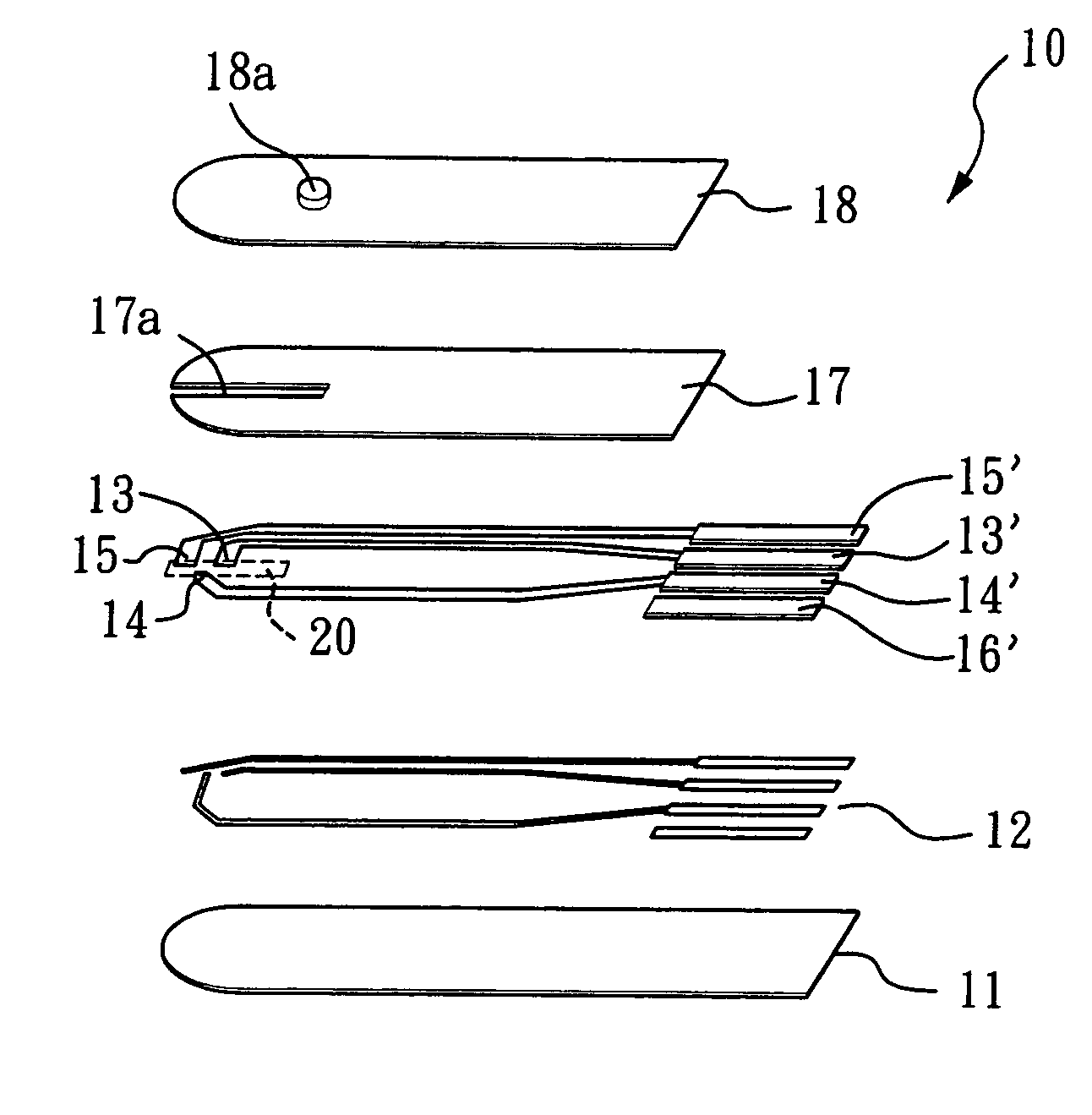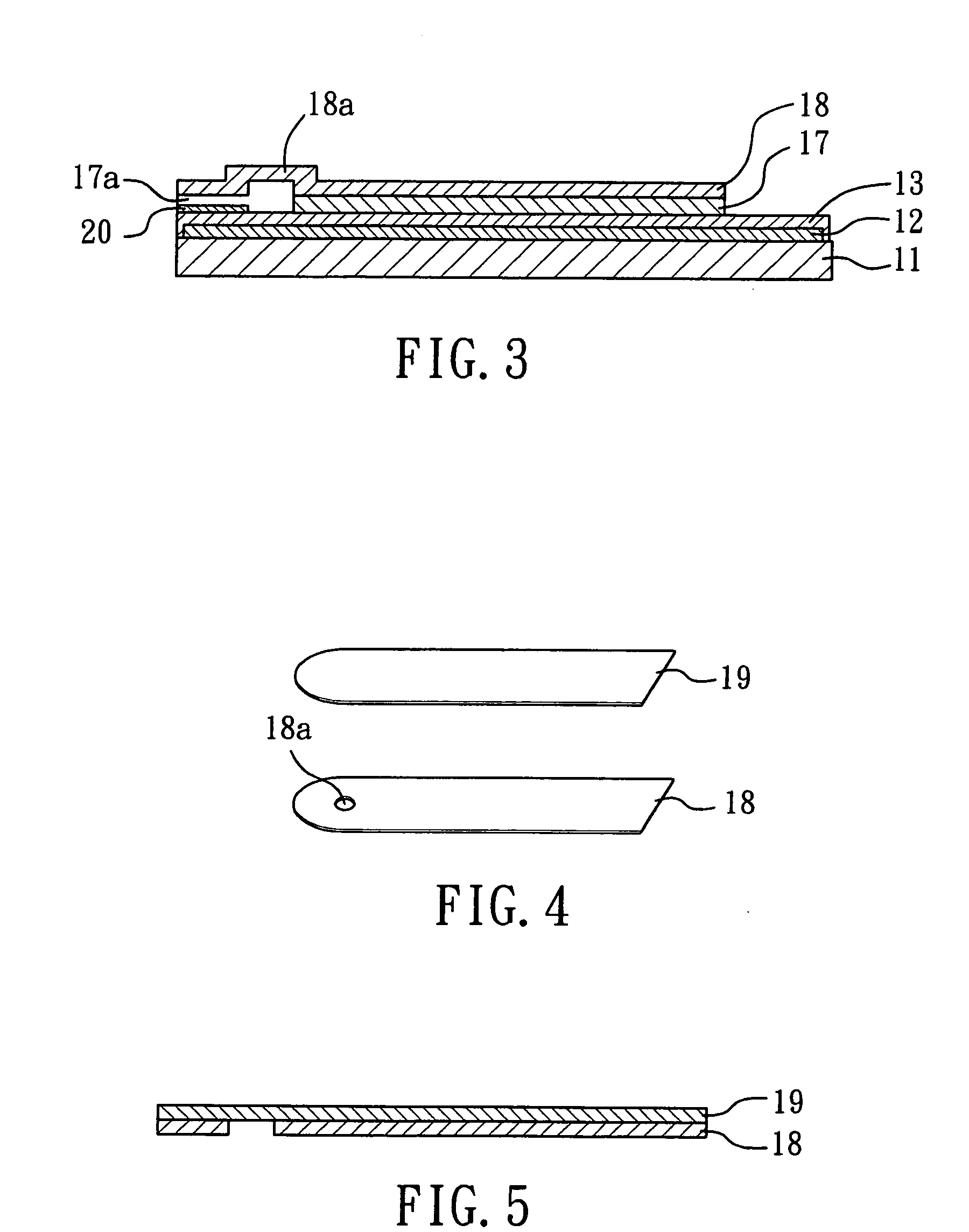Electrochemical biosensor by screen printing and method of fabricating same
a biosensor and electrochemical technology, applied in the field of electrochemical biosensors, can solve the problems of inability to effectively and efficiently control the process of affixing two insulating substrates with electrodes thereon is complicated and expensive, and the speed of filtering is still not considered ideal, etc., to achieve the effect of simple structure, less volume and rapid sample inflow
- Summary
- Abstract
- Description
- Claims
- Application Information
AI Technical Summary
Benefits of technology
Problems solved by technology
Method used
Image
Examples
example 1
Fabrication of Glucose Sensor by Screen Printing
[0028] A layer of electrically conductive silver paste is formed on a polypropylene synthetic substrate by 300 mesh screen printing, which is dried and heated for 30 minutes at 50° C., and three electrodes (working electrode, reference electrode and auxiliary electrode) are printed by carbon paste thereon. The substrate is again heated for 15 minutes at 90° C. and printed by insulating gel, which is subsequently dried and hardened under ultraviolet light to form an insulating layer with an inflow reaction area 7a, 7b and 7c (for sensors with air vents). Reaction reagents of 2-6 μl, containing 0.5-3 units of glucose oxidase, 0.1-1% of polyvinyl alcohol, pH 4.0-9.0 and 10-100 mM potassium phosphate as buffer solution, 10-100 mM potassium chloride, 0.05-0.5% of dimethylferrocene, 0.005%-0.2% tween-20, 0.005%-0.2% of surfynol and 0.1%-1.0% of carboxymethyl cellulose are spread on the recessed inflow area 7a. The substrate is dried at 45° ...
example 2
Standard Glucose Solution and Whole Blood Measurement
[0029] Standard potassium phosphate buffer solution (pH 7.4) is disposed containing glucose with a concentration of 0-400 mg / dl. The sample solution is measured by an electrochemical device (CHInstrument Co. 650A) in conjunction with a sensor according to Example 1 under a measuring potential of 100 mV for 8 seconds. The volume of sample solution is 3 μl for every measurement and the volume of sample solution introduced into the sensor for every measurement is less than 3 μl. The measuring results are listed in Table 1:
TABLE 1Results of standard glucose measurementsGlucose Concentration (mg / dl)Charge (μ coulomb) 00.690 251.532 502.9521005.2482007.4004009.577
[0030] Whole blood sample can also be measured by sensors according to the present invention. Table 2 shows results of by measuring fresh vain whole blood sample with glucose additive with a measuring potential of 100 mV and volume of 2 μl.
TABLE 2Results of whole blood mea...
example 3
Measurements of Blood Sugar with Varied Volume of Whole Blood
[0031] Electrode sensors according to Example 1 are employed, which provide whole blood samples with different volume required in the present invention. Vein whole blood samples are mixed with standard glucose solution, which in turn form solutions with a concentration of 300 mg / dl.
[0032] The method of measurements is to provide whole blood samples with different volume and supply samples by siphon under conditions set out in Example 2. As shown in FIG. 7, when the volume of a sample is insufficient (e.g., less than 0.5 μl), the concentration of glucose is low. Conversely, when the volume of a sample is above 0.8 μl the measured glucose concentration is near that in the sample solution, and the whole amount of the sample cannot be introduced into the sensor. That is, the more the volume of a sample is supplied, the more volume of the sample will be redundant, since inflow reaction area is saturated with the sample and ca...
PUM
| Property | Measurement | Unit |
|---|---|---|
| thickness | aaaaa | aaaaa |
| thickness | aaaaa | aaaaa |
| thickness | aaaaa | aaaaa |
Abstract
Description
Claims
Application Information
 Login to View More
Login to View More - R&D
- Intellectual Property
- Life Sciences
- Materials
- Tech Scout
- Unparalleled Data Quality
- Higher Quality Content
- 60% Fewer Hallucinations
Browse by: Latest US Patents, China's latest patents, Technical Efficacy Thesaurus, Application Domain, Technology Topic, Popular Technical Reports.
© 2025 PatSnap. All rights reserved.Legal|Privacy policy|Modern Slavery Act Transparency Statement|Sitemap|About US| Contact US: help@patsnap.com



